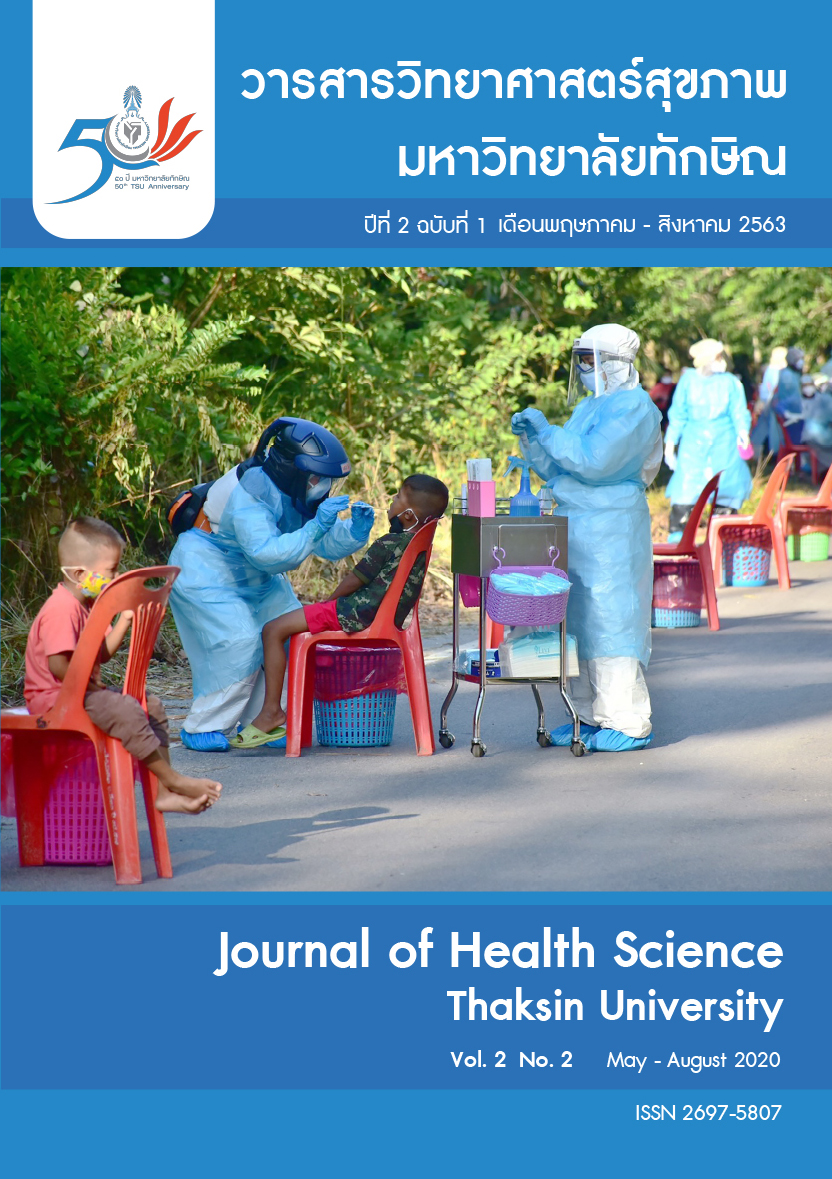Effect of Using Nursing Practice Guideline among Patients with Sepsis at Female Medical Ward in Phatthalung Hospital
Main Article Content
Abstract
This quasi-experimental study aimed to compare the effect of using clinical nursing practice guideline among patients with sepsis at female medical ward in Phatthalung Hospital. Subjects were purposively selected among patients who were diagnosed with sepsis and admitted in female medical wards, Phatthalung Hospital. The subjects were divided into 2 groups, 80 subjects per group. Subjects who received routine nursing care were assigned in control group. Subjects who received nursing practice guideline were assigned in study group. The results revealed that 1) receiving antibiotic administration rate within one hour increased from 92.50% to 100.00% (p = 0.001), 2) receiving fluid replacement within 6 hours increased from 65.00% to 88.80% (p = 0.001), 3) an average of arterial pressure rate greater than or equal to 65 mmHg increased from 71.30% to 96.30% (p <0.001), 4) urine output rate greater than 0.5ml/kg/hour increased from 62.50% to 87.50% (p = 0.002), 5) adequate tissue perfusion rate increased from 61.30% to 87.50% (p <0.001), and (6) mortality rate decreased from 31.30% to 15.00% (p = 0.015). The results suggested that nursing practice guideline among patients with sepsis should be applied to others department in the hospital in order to reduce the problem of sepsis.
Article Details
References
Van Zanten, AR., Brinkman, S., Arbous, MS., Abu-Hanna, A., Levy, MM., de Keizer, NF. Guideline bundles adherence and mortality in severe sepsis and septic shock. Critical care medicine 2014; 42(8): 890-1898.
Goto, T., Yoshida, K., Tsugawa, Y., Filbin, MR., Camago CA., Hasegawa, K. Mortality trends in U.S. adults with septic shock, 2005-2011: a serial cross-sectional analysis of nationally. representative data. BMC Infectious 2016; 16: 294-301.
Global Sepsis Alliance. [Internet] 2018 [Cited 12 July 2018]. Available from: https://www.global-sepsis-alliance.org/.
Guideline on the Ministry of Public Health Inspection. [Internet] 2018. [Cited 9 April 2018]. Available from: http://www.inspection.dmsmoph.go.th.
Pruinelli, L., Westra, BL., Yadav, P., Hoff, A., Steinbach, M., Kumar, V., Delaney, CW., Simom, G. Delay within the 3-hour surviving sepsis campaign guideline on mortality for patients with severe sepsis and septic shock. Crit Care Med 2018; 46(4): 500-505.
Rhodes, A., Evans, LE., Alhazzani, W., Levy, MM., Antonelli, M., Ferrer, R., Dellinger, RP. Surviving Sepsis Campaign: International Guidelines for Management of Sepsis and Septic Shock. Intensive Care Med 2017; 43: 304–377.
Napolitao, L. Sepsis 2018: Definition and guideline changes. Surgical infection 2018; 19(2): 117- 125.
Guttormsen, K., Ekoku, I., Treacy, J., Niranian, D., Clark L. Improving the outcomes of patients presenting with sepsis in secondary care. Wounds UK 2019; 15(5): 62-65.
Janthawang, S. Development of nursing practice guideline for septic shock patient in intensive care unit 2, Lamphun hospital. Journal of the Phrae Hospital 2018; 26(1): 35-46.
Waranung, T. Outcomes of using the clinical practice guideline for patients with sepsis at Fang hospital, Chiangmai province. Chiangrai Medical Journal 2019; 11(1) :1-8. (In Thai)
Faul, F., Erdfelder, E., Buchner, A., Lang, AG. Statistical power analyses using G*Power 3.1: Tests for correlation and regression analyses. Behavior Research Methods 2009; 41: 1149-1160.
Butsara, W., Linglom, Y., Kummuck, S. Developing a System of Care for Patients with Sepsis. Nakorn Phanom University Journal 2018; 17-25. (In Thai)
Punvittayakool, J., Maneeprai, J. The Development of Care Model for Sepsis. Journal of Nursing Division 2018; 45(1): 86-104. (In Thai)
Kumar, A., Ellis, P., Arabi, Y., Roberts, D., Light, B., Parrillo, JE., et al. Cooperative Antimicrobial Therapy of Sepsis Shock Database Research Group. Initiation of inappropriate antimicrobial therapy results in fivefold reduction of survival in human septic shock. Chest 2009; 136(5): 1237-1248.
Amphon, K., Bunyoprakarn, C., Sinkincharoen, P. The Outcomes of the Development of the Patients with Septicemia, Prapokklao Hospital. J Prapokklao Hosp Clin Med Educat Center 2017; 34(3): 222-236. (In Thai)
Hamzaoui, O., Scheeren, TWL., Teboul, JL. Norepinephrine in septic shock: when and how much. Curr Opin Critcare 2017; 23(4): 342-347.


